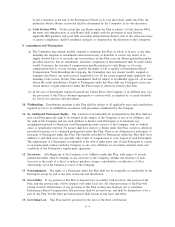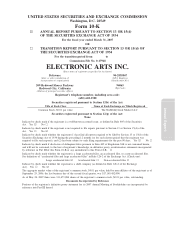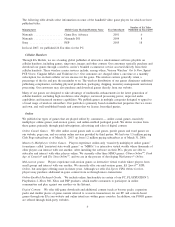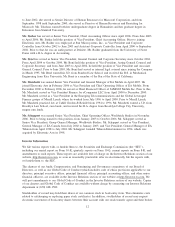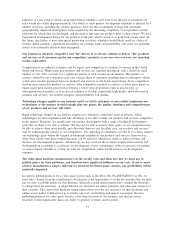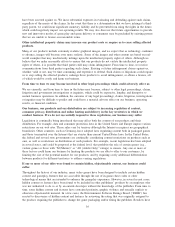Electronic Arts 2007 Annual Report Download - page 82
Download and view the complete annual report
Please find page 82 of the 2007 Electronic Arts annual report below. You can navigate through the pages in the report by either clicking on the pages listed below, or by using the keyword search tool below to find specific information within the annual report.offer them to carriers or through other sales channels. In addition, new and existing competitors are beginning
to offer wireless entertainment applications on an ad-supported basis. Currently, we consider our primary
competitors in the wireless entertainment applications market segment to be Disney, Fox Mobile Entertain-
ment, Gameloft, Glu Mobile, Hands-On Mobile, Namco, Sony Pictures and THQ Wireless.
Online Sales
The online games market segment is also highly competitive and characterized by frequent product introduc-
tions, new business models and new platforms. As the proportion of households with a broadband connection
increases, we expect new competitors to enter the market and existing competitors to allocate more resources
toward developing online games. As a result, we expect competition in the online games market segment to
intensify.
Our current and potential competitors in the online games market segment include major media companies,
traditional video game publishing companies, and companies that specialize in online games. Our competitors
in the casual games segment include MSN, Popcap, Real, AOL and Yahoo!. In the massively multiplayer
online game segment our competitors include Atari, Midway, NC Soft, Sony and Vivendi Games. In the mid-
session game segment our competitors include Nexon.
Intellectual Property
Like other entertainment companies, our business is significantly based on the creation, acquisition, exploita-
tion and protection of intellectual property. Some of this intellectual property is in the form of software code,
patented technology, and other technology and trade secrets that we use to develop our games and to make
them run properly on the platforms. Other intellectual property is in the form of audio-visual elements that
consumers can see, hear and interact with when they are playing our games — we call this form of intellectual
property “content”.
Each of our products embodies a number of separate forms of intellectual property protection: the software
and the content of our products are copyrighted; our products may use patented inventions or trade secrets; our
product brands and names may be trademarks of ours or others; our products may contain voices and
likenesses of actors, athletes and/or commentators (which may be protected by personal publicity rights) and
often contain musical compositions and recordings that are also copyrighted. Our products also may contain
content licensed from others, such as trademarks, fictional characters, storylines and software code.
We acquire the rights to include wholly-owned intellectual property in our products by creating the intellectual
property within our EA Studios. We also acquire the rights to include proprietary intellectual property in our
products through acquisitions. We also enter into content license agreements such as those with sports leagues
and player associations, movie studios and performing talent, music labels, music publishers and musicians.
These licenses are typically limited to use of the licensed rights in products for specific time periods. In
addition, our products that play on game consoles, handhelds and cellular handsets include technology that is
owned by the console manufacturer and licensed non-exclusively to us for use. While we may have renewal
rights for some licenses, our business and the justification for the development of many of our products is
dependent on our ability to continue to obtain the intellectual property rights from the owners of these rights
at reasonable rates.
Our products are susceptible to unauthorized copying. We typically distribute our PC products using copy
protection technology that we license from other companies. In addition, console manufacturers, such as Sony,
typically incorporate security devices in their consoles in an effort to prevent the use of unlicensed products.
Our primary protection against unauthorized use, duplication and distribution of our products is enforcement
of our copyright and trademark interests. We typically own the copyright to the software code as well as the
brand or title name trademark under which our products are marketed. We register our copyrights and
trademarks in the United States and other countries.
8



